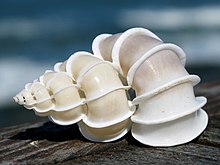Epitonium
| Epitonium | |
|---|---|
 |
|
| The sculpture of the shell of Epitonium scalare has raised ribs that are known as costae. Costae are an almost universal feature in shells of Epitonium species. | |
| Scientific classification | |
| Kingdom: | Animalia |
| Phylum: | Mollusca |
| Class: | Gastropoda |
| (unranked): |
clade Caenogastropoda clade Hypsogastropoda |
| Superfamily: | Epitonioidea |
| Family: | Epitoniidae |
| Genus: |
Epitonium Röding, 1798 |
| Type species | |
|
Epitonium scalare Linnaeus, 1758 |
|
| Species | |
|
See text |
|
| Synonyms | |
|
See text |
|
clade Hypsogastropoda
informal group Ptenoglossa
See text
See text
Epitonium is a genus of small predatory sea snails, marine gastropod mollusks. Epitonium is the type genus of the family Epitoniidae, the wentletraps.
The common name wentletraps is derived from the Dutch word wenteltrap, denoting a spiral staircase. This refers to the striking form and sculpture of the shells of the mollusks in this genus, and to a lesser extent, the whole family.
The genus Epitonium has been divided in the past by some authors into several subgenera, but these subgenera were based only on shell characters and did not reflect the true underlying relationships or phylogeny.
Epitonium shells are high-spired, and are all-white in most of the species within this genus. A few species are tinted with brown to varying degrees, or have a brown stripe on the shoulder of the whorl. The shells typically have blade-like vertical ribs, known as costae.
Wentletraps usually live in sand near sea anemones or corals.
These snails are predators and feed by inserting their proboscis and biting out small pieces of the anemone's tissues. Some species of wentletrap feed on only one species of sea anemone, in other words they are species-specific in terms of their prey.
Many species that now are placed in the genus Epitonium have, over the years, been classified in other genera. These have become synonyms of Epitonium :
...
Wikipedia
